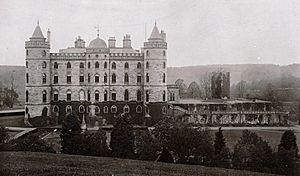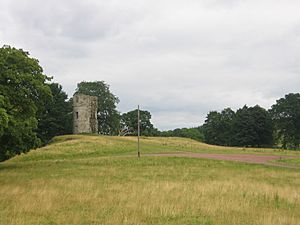Douglas Castle facts for kids
Quick facts for kids Douglas Castle |
|
|---|---|

Douglas Castle (demolished in 1938)
|
|
|
Listed Building – Category C(S)
|
|
| Designated | 12 January 1971 |
| Reference no. | LB1449 |
| Lua error in Module:Location_map at line 420: attempt to index field 'wikibase' (a nil value). | |
Douglas Castle was a very old and important home for the Douglas family in Scotland. This family was powerful for hundreds of years. The castle was built and rebuilt many times. The first one was from the 1200s. The last big house built here was taken down in 1938. Today, only a small part of an older tower is left. This castle was once the home of a former Prime Minister, Sir Alec Douglas-Home. The castle ruins are near the village of Douglas, South Lanarkshire, in south-west Scotland.
Contents
The Story of Douglas Castle
Building the First Castle
The Douglas family built the first Douglas Castle before the year 1288. It might have been made of wood or stone. This castle was their main family home.
Douglas Castle in Wartime
In 1307, Scotland was fighting for its freedom from England. This was called the Wars of Scottish Independence. English soldiers, led by Lord Clifford, took over Douglas Castle.
Sir James Douglas was a close friend of Robert the Bruce, the Scottish king. Sir James wanted his family home back. He attacked the castle on a Sunday morning while the English soldiers were at church. He defeated the soldiers and then burned the castle down. This event became known as "Douglas' larder."
The Powerful Douglas Family
Robert the Bruce rewarded the Douglas family for their loyalty. Sir James's family became very important Earls of Douglas. Douglas Castle was rebuilt as one of their strongholds.
But by the 1400s, the "Black" Douglas family became too powerful. They started to challenge the king, James II. In 1455, the king fought against the 9th Earl of Douglas. The king won the battle. Douglas Castle was then destroyed, and the family lost their lands and titles.
New Owners and Rebuilding
Another part of the Douglas family, called the "Red" Douglases (the Earls of Angus), had supported the king. So, they were given the Douglas lands in Scotland. It is likely that the castle was rebuilt again soon after 1455.
The Grand Mansion
In 1703, Archibald Douglas became the Duke of Douglas. He made Douglas Castle his main home. The castle was rebuilt once more around this time. It was a tower house with a walled courtyard.
In 1755, this castle was badly damaged by a fire. Only one corner tower was left standing.
From 1757, the Duke started building a huge new house at Douglas. It was designed by famous architects, the Adam Brothers. If it had been finished, it would have been the biggest house in Scotland. But the Duke died in 1761, and only about half of the design was built.
The Duke's estate became part of a famous legal fight called the "Douglas Cause". This was a dispute over who would inherit the property. In the end, Archibald James Edward Douglas, the Duke's nephew, won. The castle then passed down through his family to the Earls of Home.
Why the Castle Was Demolished
In the 1930s, Charles Douglas-Home, 13th Earl of Home allowed coal mining near the castle. He did this to help people in the area find jobs. Sadly, the mining caused the ground under the castle to sink. This made the castle unsafe. So, in 1938, the grand mansion had to be taken down.
Douglas Castle Today
Today, only a ruined corner tower from the 1600s castle remains. This tower is about 9 meters (30 feet) tall. It used to be part of a large walled area. The tower stands on a small hill near the river. It was kept as a decorative ruin when the later mansion was built. There is also a small cellar block below it. Nothing is left of the large mansion that was built later.
The writer Walter Scott used the story of Douglas Castle as the idea for his novel Castle Dangerous. Because of this, the castle is sometimes still called by that name.


